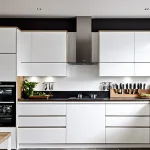Unique Principles That Drive British Kitchen Space Efficiency
British kitchen design is deeply rooted in space-saving principles, reflecting both historical and cultural influences that prioritize practicality without sacrificing style. At its core, efficient kitchen layouts in British homes emphasize maximizing every inch of available space, recognizing that many residences feature compact kitchens.
One key tenet of British kitchen efficiency is the strategic use of vertical storage. Tall cabinets and wall-mounted shelves allow for more storage capacity, reducing clutter and freeing up valuable counter space. This approach contrasts with some international kitchen design methods that may favor expansive countertops or separate pantry areas, which are less feasible in smaller British homes.
Also read : Integrating cutting-edge tech in your cozy uk kitchen: innovative ideas and tips
Historically, British kitchens evolved to accommodate smaller living quarters, a result of urbanization and post-war housing developments. These kitchens were designed to be highly functional, incorporating clever solutions such as integrated appliances and multi-purpose furniture. This historical backdrop continues to influence modern British kitchen layouts, where adaptability and smart use of space remain paramount.
In summary, British kitchen design prioritizes efficient kitchen layouts by embracing compact, practical solutions that differ from more spacious, sometimes less restrained international designs. Understanding these principles offers valuable insights for anyone looking to optimize kitchen functionality in limited spaces.
Also read : Maximizing efficiency in your compact uk kitchen: smart tips and tricks
Clever Storage Solutions and Functional Cabinetry
Smart kitchen storage transforms the heart of your home by combining British cabinetry craftsmanship with innovative space-saving techniques. Integrated cabinetry and custom-built features provide seamless storage options tailored to your kitchen’s unique layout, ensuring every inch is utilised effectively.
Pull-out storage systems reveal hidden drawers and shelves, making items easily accessible without cluttering countertops. Corner storage solutions, often overlooked, use rotating carousels or swing-out units that maximise typically wasted spaces. Vertical storage systems take advantage of height, allowing for shelving that can accommodate various kitchen tools and pantry items without overwhelming the space.
Concealed storage options preserve a clean and sophisticated look by hiding away appliances or utensils when not in use. Multi-level storage compartments further optimise small spaces, enabling separation of items by use or size and reducing the need for additional cabinetry. By combining these techniques, smart kitchen storage using premium British cabinetry offers a functional yet elegant solution adaptable to any kitchen size or style.
Multi-Functional Furnishings for Everyday Versatility
In modern British kitchens, multi-functional kitchen furniture plays a crucial role in maximizing space while enhancing practicality. Space-saving furniture, such as expandable tables and folding worktops, allows homeowners to adapt their kitchen layout to suit different needs throughout the day. For instance, an expandable table can serve as a compact breakfast nook in the morning and transform into a spacious dining area by evening, addressing common UK kitchen space limitations effectively.
Dual-purpose islands are becoming increasingly popular in British kitchen trends. These islands often combine storage with seating or incorporate hidden appliances to maintain a clean and uncluttered look. Such features exemplify smart design, where every component serves multiple functions, thereby minimizing clutter and maximizing usable surface area. Modular solutions, widely adopted in UK homes, allow for components to be rearranged or extended, providing flexibility in how a kitchen is used. For example, a kitchen island might include integrated seating that can be tucked away or extended as needed, demonstrating how space-saving furniture meets both aesthetic and functional demands.
By prioritizing multi-functional kitchen furniture, homeowners can create kitchens that adapt seamlessly to daily routines without sacrificing style or efficiency. This approach reflects a broader trend in British kitchens towards versatile, innovative furnishings that cater to smaller spaces and evolving household needs.
Compact Floor Plan Strategies for British Kitchens
Small kitchen ideas in British homes often revolve around efficient kitchen layouts that make the most of limited space. The most common British kitchen planning approaches involve galley, L-shaped, and U-shaped layouts. Each offers unique advantages when it comes to organising a compact kitchen.
A galley kitchen maximises narrow spaces by placing countertops and appliances on two parallel walls, allowing for an efficient workflow but requiring careful attention to circulation to avoid congestion. L-shaped layouts combine two walls at right angles, providing an open corner that can enhance movement and accommodate additional storage or seating. U-shaped kitchens surround the cook on three sides, offering ample workspace but needing sufficient clearance to allow for ease of access.
Circulation patterns and accessibility are crucial in British kitchen planning. Narrow corridors can restrict movement, so maintaining at least 900mm of walkway space ensures everyone can move comfortably. Thoughtful placement of appliances opposite work areas supports smooth traffic flow, preventing bottlenecks in busy kitchens.
To maximise usable space, strategic placement of cupboards and appliances is key. Height is often underutilised; wall-mounted cupboards can extend storage vertically without encroaching on floor area. Corner spaces can be transformed with carousel units or pull-out drawers, which are especially beneficial in smaller British kitchens. Combining these strategies results in a kitchen that feels larger and functions more effectively, even within the constraints of compact floor plans.
Real Life Examples: British Kitchens in Action
Exploring case studies reveals how UK kitchen design masters space optimization even in compact settings. One homeowner transformed a narrow galley kitchen into a multifunctional hub by incorporating vertical storage and pull-out cabinets. This not only increased usability but also created a visually uncluttered space. The result was a transformation that balanced style and practicality without sacrificing valuable square footage.
In another British kitchen renovation, integrating built-in appliances and cleverly positioned lighting turned a small room into an inviting cooking area. Homeowners emphasized the importance of tailored storage solutions in optimizing their limited space. Their testimonials underline how thoughtful space optimization can drastically improve daily life and functionality.
Visual walkthroughs of these renovations often highlight innovative features such as concealed pantries, fold-down tables, and modular shelving units. These elements demonstrate how UK kitchen design blends form and function to create efficient living spaces. Such examples serve as inspiration for homeowners facing similar spatial challenges, showing that creative design unlocks potential in any kitchen size.
Practical Tips: Bringing British Space Efficiency Into Your Home
British-inspired kitchens are celebrated for their clever use of space, making even the smallest areas both functional and inviting. To incorporate these kitchen space-saving tips into your home, focus on maximizing storage and ensuring smooth flow. Start by assessing your kitchen layout to identify underutilized corners or wall space where shelves or hooks can be added. Utilizing vertical storage is a hallmark of British space efficiency, so installing tall cabinets or open shelving can significantly boost storage without enlarging the footprint.
DIY modifications play a key role in home improvement advice for boosting kitchen usability. Consider adding pull-out pantry units or modular shelves inside cabinets to make the most of deep storage areas. Magnetic strips for knives or spice jars affixed to inside cabinet doors free up counter space while keeping essentials within reach. These practical changes enhance both accessibility and tidiness.
When sourcing British-style fittings and accessories, look for classic designs such as traditional brass handles, ceramic knobs, or enamelware that bring a timeless charm. Mixing these with modern elements creates a balanced look that honors British design traditions while fitting contemporary needs. Incorporating these kitchen space-saving tips inspired by British efficiency helps create a well-organized, efficient kitchen tailored to your lifestyle.

